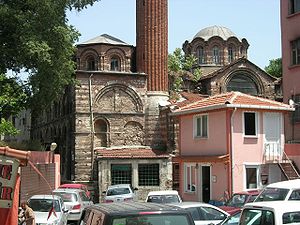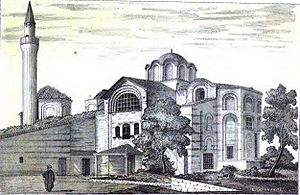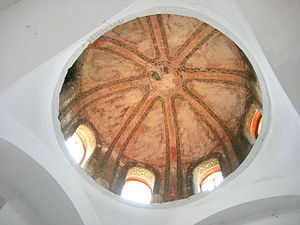- Vefa Kilise Mosque
-
Vefa Kilise Mosque
Vefa Kilise Camii
The mosque (right) and the exonarthex (left) viewed from the south.
Basic information Location Istanbul, Turkey Geographic coordinates 41°0′59″N 28°57′37″E / 41.01639°N 28.96028°E Affiliation Sunni Islam Year consecrated Short after 1453 Architectural description Architectural type church Architectural style Middle Byzantine - Comnenian Completed End 11th - begin 12th century Specifications Minaret(s) 1 Materials brick, stone Vefa Kilise Mosque (Turkish: Vefa Kilise Camii, meaning "the church mosque of Vefa", to distinguish it from the other kilise camiler of Istanbul: also known as Molla Gürani Camii after the name of his founder) is a former Eastern Orthodox church converted into a mosque by the Ottomans. The church was possibly dedicated to Hagios Theodoros (St. Theodore,[1] in Greek: ἡ Ἐκκλησία του Ἁγίου Θεοδόρου), but this dedication is far from certain.[2] The complex represents one of the most important examples of Comnenian and Palaiologan architecture of Constantinople.[3]
Contents
Location
The building lies in Istanbul, in the district of Fatih, in the neighborhood of Vefa, less than one kilometer to the northwest of the other great Byzantine building in Vefa (the mosque of Kalenderhane), and a few hundred meters south of the Süleymaniye Mosque.
History
The origin of the building, which lies on the slope of the third hill of Constantinople, is not certain. Judging by its masonry, it was erected between the end of the 11th and the beginning of the 12th centuries, during the reign of Alexios I Komnenos. The dedication to Hagios Theodoros[4] is also far from certain.[2] During the Latin domination of Constantinople after the Fourth Crusade the edifice was used as a Roman Catholic church.
Shortly after the Ottoman conquest of Constantinople, the church became a mosque, founded by the famous Kurdish scholar Molla Gürani, who was the tutor of Sultan Mehmed II and would become the first Mufti of Istanbul. The mosque is also named after him. In 1833, a fire ravaged the complex destroying the wooden annexes. In 1937, the building underwent a partial restoration, and its surviving mosaics were uncovered and cleaned.
Architecture and decoration
The church proper, which has never been studied systematically,[2] has a cross-in-square (or quincunx) plan, with each side nine meters long.[5] Together with the Eski Imaret Mosque, provides an example of the Komnenian style in Constantinople. Its masonry consists of bricks, mounted adopting the technique of the recessed brick, typical of the Byzantine architecture of the middle period.[6] In this technique, alternate courses of brick are mounted behind the line of the wall, and are plunged into a mortar bed. Due to that, the thickness of the mortar layers is about three times greater than that of the brick layers.
The building has blind arcades, and the apse is interrupted by a triple lancet window with niches over it. The light penetrates into the cross arms through triple arcades. The exterior of the main church has occasional decorative motifs, such as snake patterns.
Besides this building, the complex contains also an exonarthex to the west, a portico (which joins a parekklesion[7] with the bema) with columns and arches to the south, and finally a corridor to the north.
The exonarthex represents one of the most typical examples of Palaiologan architecture in Constantinople,[8] along with the parekklesia of the Pammakaristos, the Chora Churches, and Fethiye Mosque. The date of its edification should be placed after those of the parekklesia of the Pammakaristos and Chora Churches.[9] Its façade has two orders, both opened with arcades. On the lower order there are angular niches followed by triple arcades. The higher order is quite different from the lower, and has five semicircular blind arcades framing windows. The masonry is made of banded and colorful brickwork and stonework, especially visible on the north side. Overall, the execution is less refined than in the parekklesion of the Fethiye Mosque.[9]
The exonarthex is surmounted by three domes. The lateral ones are of umbrella type, while the central one has ribs. The internal decoration of the exonarthex includes: columns, capitals and closure slabs which are all reused material from the Early Byzantine period.[2] The three domes were all covered with mosaics. Those on the south dome were cleaned in 1937 under the direction of the Ministry of Mosques,[2] but as of 2007 they have disappeared almost completely. The interior of the church proper, on the contrary, has never been de-plastered up to now.
Two fairly large underground cisterns placed to the S and W of the church hint to the existence of a monastery in the byzantine age. [10]
References
- ^ To which of the many saints bearing the name Theodore the church was dedicated is not clear. He could be either St. Theodore of Tyre or St. Theodore Stratelates. A joint dedication could also have been possible. Van Millingen (1912), p. 245
- ^ a b c d e Mathews (1976), p. 386.
- ^ Van Millingen (1912), p. 246.
- ^ According to Pierre Gilles, the church of Hagios Theodoros was placed in the surroundings of today's Vefa Kilise Mosque.
- ^ Krautheimer (1986), p. 407.
- ^ Krautheimer (1986), p. 400.
- ^ The parekklesion is a chapel leaning to the side of the church or of the narthex.
- ^ Krautheimer (1986), p. 483.
- ^ a b Krautheimer (1986), p. 484.
- ^ Mamboury (1953), p. 303
Sources
- Van Millingen, Alexander (1912). Byzantine Churches of Constantinople. London: MacMillan & Co.
- Mamboury, Ernest (1953). The Tourists' Istanbul. Istanbul: Çituri Biraderler Basımevi.
- Mathews, Thomas F. (1976). The Byzantine Churches of Istanbul: A Photographic Survey. University Park: Pennsylvania State University Press. ISBN 0-271-01210-2.
- Krautheimer, Richard (1986) (in Italian). Architettura paleocristiana e bizantina. Turin: Einaudi. ISBN 88-06-59261-0.
Church-Mosques (Kilise-Camiler) in Istanbul Arap (SS. Paul and Dominic) · Atik Mustafa Pasha (St. Thekla) · Bodrum (Myrelaion) · Eski Imaret (Christ Pantepoptes) · Fenari Isa (Lips Monastery) · Fethiye (Pammakaristos) · Gül (St. Theodosia / Christ Euergetes) · Hagia Sophia · Hirami Ahmet Pasha (St. John in Trullo) · Imrahor (Stoudios Monastery) · Kalenderhane (Kyriotissa) · Kariye (Chora Monastery) · Kefeli (Monastery of Manuel / St. Nicholas) · Koca Mustafa Pasha (St. Andrew in Krisei) · Little Haghia Sophia (SS. Sergius and Bacchus) · Manastır · Odalar (St. Mary of Constantinople) · Sancaktar Hayrettin (Gastria Monastery) · Şeyh Süleyman · Vefa Kilise (St. Theodore) · Zeyrek (Christ Pantokrator, Theotokos Eleousa & St. Michael)
Categories:- Mosques converted from churches in Istanbul
- 12th-century architecture
- 14th-century architecture
- Byzantine sacred architecture
- Fatih, Istanbul
- 12th-century Eastern Orthodox church buildings
- 14th-century church buildings
Wikimedia Foundation. 2010.





